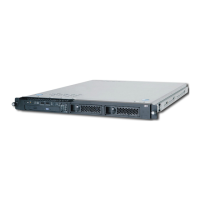The following table outlines the IPL phases from power-on to the AIX login prompt,
matching the phases to corresponding operator panel checkpoints for a typical system
boot. Also listed are the approximate boot times for each phase, along with their
dependencies for each phase.
Note: The table below lists the major checkpoints only.
Phase # Checkpoints on
Operator Panel
Time in phase
(minutes)
Major contributors to time in phase
Phase 1 Power-on 3 to 4 Number of I/O drawers
C1yx 1xxx
C1yx 80xx
C3yx xxxx
E0xx
Phase 2 C3yx xxxx 1 to 4 (Fast) Fast/Slow boot setting
(blank) 5 to 15+ (Slow) Amount of memory
Number of processors
Phase 3 Eyxx 3 to 9+ Number of I/O drawers
0000 Number of bootable adapters
Phase 4 0000 2 - 30+ Number of SSA drives
(blank) Number of Adapters
Number of Async sessions
Number of SCSI devices
Amount of memory
Checkpoints enable users and service personal to know what the server is doing, with
some detail, as it initializes. These checkpoints are not intended to be error indicators,
but in some cases a server could hang at one of the checkpoints without displaying an
8-character error code. It is for these hang conditions, only, that any action should be
taken with respect to checkpoints. The most appropriate action is included with each
checkpoint.
Before taking actions listed with a checkpoint, check for additional symptoms in the
service processor error log. See the “System Information Menu” on page 457 for
information on how to access the service processor error log.
Note: Go to “MAP 1540: Minimum Configuration” on page 117 for any of the following
checkpoint hang conditions. If mentioned as an action, remember to run the
system-rack minimum configuration:
v A four-digit code in the range of E001 through EFFF not listed in the
checkpoint tables.
v A four-digit code is in the checkpoint tables, but does not contain a repair
action or FRU listing.
136 Service Guide
